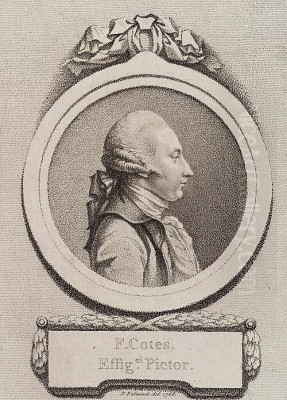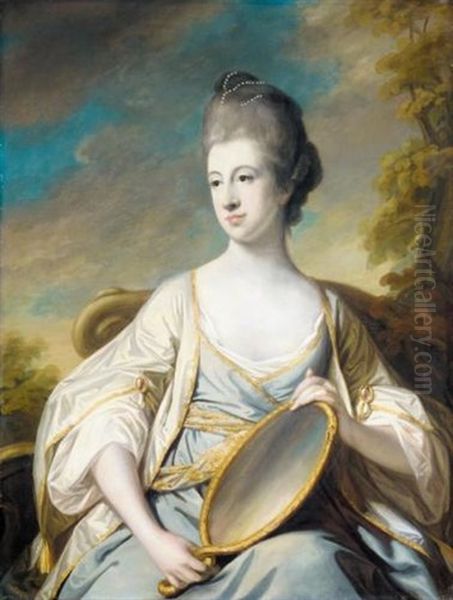
Francis Cotes (1726-1770) stands as a significant figure in the landscape of 18th-century British art. A master of both pastel and oil painting, he captured the likenesses of Georgian society with remarkable sensitivity and technical brilliance. Though his career was tragically cut short, his contributions, particularly his pioneering work in pastels, secured his place alongside the leading portraitists of his era.
Early Life and Artistic Formation
Born in London in 1726, Francis Cotes hailed from a respectable background. His father was an apothecary, a profession that placed the family within the educated middle class. An interesting familial connection was his paternal grandfather, Francis Lynn, who served as the chief secretary to the Royal African Company, indicating a certain level of societal standing. The family also maintained strong connections to Ireland, although Cotes's father faced political difficulties, reportedly being convicted of treason for opposing policies related to the Irish Parliament.
Against this backdrop, the young Francis Cotes pursued an artistic path. His formal training began under the tutelage of George Knapton (c. 1698–1778), a respected portrait painter and a founding member of the Society of Dilettanti. Knapton's influence likely provided Cotes with a solid foundation in drawing and painting techniques, essential for a career focused on capturing the human form and character. Cotes quickly absorbed these lessons, demonstrating a natural aptitude for the arts.
The Ascendancy of the Pastel Portrait
Cotes initially established his reputation through his exquisite work in pastels. In the mid-18th century, pastels gained considerable popularity across Europe, favoured for their soft textures, vibrant colours, and the speed with which artists could achieve finished results. Cotes became one of the foremost practitioners of this medium in Britain, often hailed as a pioneer who elevated its status within the national school.

His approach to pastel was both technically adept and aesthetically refined. He developed a method of applying the chalks in thin, delicate layers, sometimes blending them to achieve subtle gradations of tone that could mimic the smoothness of oil paint. This technique allowed for a clarity and warmth that greatly appealed to his clientele. His pastel portraits are characterized by their naturalism, capturing not just a physical likeness but also a sense of the sitter's personality and presence.
Cotes's style in pastel drew inspiration from continental masters. He greatly admired the work of the Venetian pastellist Rosalba Carriera (1675–1757), whose elegant and flattering portraits had set the standard across Europe. He was also significantly influenced by the Swiss artist Jean-Étienne Liotard (1702–1789), who worked in London during the 1750s. Liotard's meticulous detail and truthful representation encouraged Cotes to refine his own technique, pushing towards greater precision and psychological depth in his pastel work. Some contemporaries, including his own pupil John Russell, even referred to Cotes as the "Rosalba Carriera of England," high praise indeed.
Mastery of Oil Painting
While pastels brought him initial fame and remained a medium he clearly favoured, commercial pressures and the desire to compete at the highest levels of the London art world led Cotes to increasingly focus on oil painting from the 1760s onwards. The perceived permanence and grandeur of oil portraits often commanded higher prices and greater prestige, particularly for large-scale commissions.
His transition to oils was remarkably successful. He adapted his techniques, retaining the clarity, warmth, and delicate colour harmonies that distinguished his pastels. His oil paintings often exhibit a smooth finish and careful attention to detail, particularly in the rendering of fabrics and accessories. While distinct from the bolder, more painterly approach of contemporaries like Thomas Gainsborough (1727–1788), Cotes's oils possessed their own quiet elegance and charm.
In his oil portraits, Cotes often aimed for a style that could stand alongside the work of the dominant figure in British portraiture, Sir Joshua Reynolds (1723–1792). While perhaps not achieving Reynolds's dramatic flair or intellectual depth derived from Old Masters, Cotes offered a compelling alternative, often perceived as more direct and less idealized, yet still highly fashionable and sophisticated. His compositions were well-structured, his drawing accurate, and his ability to capture a pleasing likeness was highly valued.
Notable Works and Signature Style
Francis Cotes produced a considerable body of work during his relatively short career. Several key pieces exemplify his skill and stylistic characteristics across both pastels and oils.
His pastel Portrait of Mary Colebrooke (c. 1750s) is often cited as one of his finest achievements in the medium. It showcases his delicate handling, subtle colour blending, and ability to convey a sense of gentle refinement. The sitter's gaze is direct yet soft, and the rendering of her attire demonstrates his early mastery of texture.
Another significant pastel is the Portrait of a Young Lady, which highlights his mature pastel style, potentially showing influences from French artists like Maurice Quentin de La Tour (1704–1788) in its sophistication and elegance. The attention to the intricate details of the costume and the sitter's poised demeanor are characteristic of his best work.
In oils, the double portrait The Young Couple Playing Chess (c. 1768-70) reveals his skill in composing multi-figure scenes and capturing informal moments. The warmth of the palette and the engaging interaction between the sitters create a charming and lifelike image, demonstrating his successful adaptation to the oil medium.
Perhaps his most prestigious commission was the Portrait of Queen Charlotte with her Eldest Daughter, Charlotte, Princess Royal (1767). This royal portrait, now in the Royal Collection, cemented his status among the leading court painters. It combines regal formality with a touch of maternal tenderness, rendered with the clarity and careful finish typical of Cotes's oil paintings. It placed him in direct competition with artists like Reynolds and the German neoclassical painter Anton Raphael Mengs (1728-1779), who also painted European royalty.
He also painted prominent figures such as Admiral Harry Paulet, 6th Duke of Bolton, showcasing his ability to capture the authority and character of male sitters within the conventions of aristocratic portraiture. His portrait of the actress George Anne Bellamy further demonstrates his engagement with the wider social and cultural milieu of London.
Across his oeuvre, Cotes consistently demonstrated a keen eye for fashion and detail. His meticulous rendering of silks, satins, lace, and powdered hair not only delighted his patrons but also provides valuable visual documentation of mid-18th-century costume. This attention to surface texture, combined with strong drawing and pleasing compositions, defined his appealing style.
Artistic Network and Professional Life
Francis Cotes was an active participant in the burgeoning London art scene. His relationship with his teacher, George Knapton, provided his initial entry point. As his reputation grew, he developed a network that included fellow artists, patrons, and students.
His younger brother, Samuel Cotes (1734–1818), was also an artist, primarily known as a successful painter of miniatures, though he occasionally worked in pastels as well. The brothers likely shared insights and possibly studio space at times, contributing to a familial artistic environment.
Francis Cotes took on pupils, passing on his skills, particularly in pastel. Notable students included John Russell (1745–1806), who would become a prominent pastellist in his own right and wrote admiringly of his master's techniques, and William Burgess. Teaching helped solidify Cotes's influence on the next generation of British artists working in crayon. James Russell, another student, also documented Cotes's prowess as a "Crayon Painter."
Cotes was deeply involved in the professional organization of artists in London. He was a key figure in the Society of Artists of Great Britain, which held annual exhibitions to showcase members' work. He served as the society's president in 1765, demonstrating his standing among his peers.
More significantly, Cotes was one of the founding members of the Royal Academy of Arts in 1768. This prestigious institution, established under the patronage of King George III with Sir Joshua Reynolds as its first president, aimed to raise the status of art and artists in Britain. Cotes's inclusion among the initial 34 foundation members underscores his importance. He exhibited actively at the Academy's early exhibitions, showcasing eighteen works in the inaugural exhibition of 1769, further cementing his position alongside Reynolds and Gainsborough as a leader of the British school. His fellow academician, the flower painter Mary Moser (1744–1819), remembered him fondly.
Technical Innovations and Writings
Beyond his finished artworks, Cotes contributed to the technical understanding of his chosen media. His student John Russell recorded some of Cotes's methods, suggesting a systematic approach to pastel painting. There is evidence that Cotes experimented with techniques to enhance the durability and visual effect of pastels.
One specific technique associated with him, possibly learned or adapted from continental practice, involved using water or another binding medium with the pastel pigments, sometimes referred to as a "wet" method. This could create denser, more transparent layers, allowing for effects closer to watercolour or gouache while still using pastel sticks. This technical curiosity demonstrates his desire to push the boundaries of the medium.
Furthermore, Cotes is known to have written a short treatise or paper on the art of pastel painting. While the full extent and influence of this text are debated, its existence points to his reflective nature and his willingness to codify and share his expertise. Such writings were relatively rare among British artists of the period and highlight his intellectual engagement with his craft.
Personal Life and Untimely Death
Francis Cotes married Sarah Adderley in 1765. By all accounts, the marriage was a happy one. His professional success allowed him to maintain a fashionable residence and studio, first in Percy Street and later, more grandly, in Cavendish Square, a prestigious London address that reflected his status.
Tragically, Cotes's flourishing career and life were cut short. In 1770, while suffering from kidney stones or gallstones ("the stone," a common and painful ailment at the time), he resorted to a dangerous self-administered remedy. He ingested a solution of soap, believing it would dissolve the stones. Instead, the caustic concoction poisoned him. He died on 19 July 1770, at the young age of 44.
His sudden death shocked the London art world. Mary Moser, expressing the sentiments of many, wrote of his passing, lamenting the loss of not just a talented artist but also a kind man, describing him as a "sincere friend to the afflicted." His wife Sarah acted as the executor of his will, inheriting the bulk of his estate. Her annotations on some of his works later provided valuable information for art historians.
Legacy and Influence
Despite his premature death, Francis Cotes left a significant legacy. He was instrumental in establishing pastel as a serious and respected medium for portraiture in Britain. His technical skill and elegant style set a high standard, influencing subsequent generations of pastellists, most notably his pupil John Russell.
His oil paintings, while sometimes overshadowed by the towering reputations of Reynolds and Gainsborough, hold an important place in the history of British portraiture. They offer a distinct vision, characterized by clarity, refinement, and a gentle naturalism that appealed greatly to Georgian sensibilities. His ability to capture likeness and render fashionable attire with precision made him highly sought after.
As a founding member of the Royal Academy, Cotes played a role in shaping one of Britain's most enduring cultural institutions. His participation lent credibility to the new Academy and helped define the scope of contemporary British art.
Today, Francis Cotes is recognized as one of the leading British portraitists of the mid-18th century. His works are held in major collections worldwide, including the National Portrait Gallery and Tate Britain in London, the Royal Collection Trust, and numerous museums in North America. His paintings and pastels continue to be admired for their technical brilliance, aesthetic charm, and insightful portrayal of Georgian society, securing his enduring reputation as a master of his craft whose potential was sadly curtailed by his early demise.